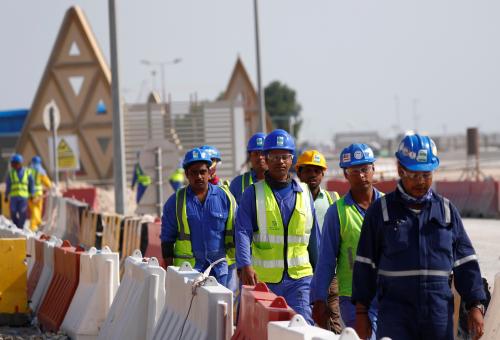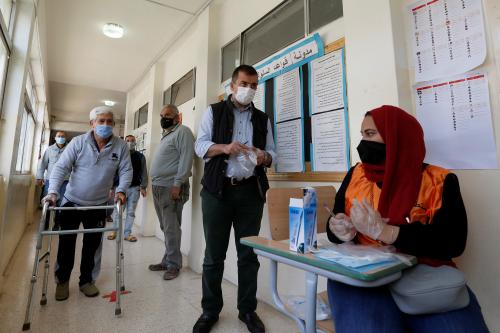Content from the Brookings Doha Center is now archived. In September 2021, after 14 years of impactful partnership, Brookings and the Brookings Doha Center announced that they were ending their affiliation. The Brookings Doha Center is now the Middle East Council on Global Affairs, a separate public policy institution based in Qatar.
After the anti-Mubarak “Day of Rage” demonstrations ignited across Egypt on January 25, U.S. Secretary of State Hillary Clinton offered this flimsy reaction: “Our assessment is that the Egyptian government is stable and is looking for ways to respond to the legitimate needs and interests of the Egyptian people.” Secretary Clinton’s indicators of stability are questionable – the first day of demonstrations resulted in four dead, five hundred arrested, and angry protests flaring in every corner of the country. There were talks that the government shut down Facebook and Twitter. It was rumored to have scrambled cell phone signals. These events are absolutely, and by all standards, unprecedented in the recent history of Egypt. The scale and intensity of anti-Mubarak protests in the streets have not been seen in living memory. More significantly, it is clear that the Egyptian people have crossed the fear barrier. They are ready for a fight. The United States must now recognize the significance of this moment.
While it is still premature to predict the trajectory of the demonstrations, indicators of instability in Egypt bear a striking resemblance to the Tunisian model that led to the toppling of that country’s regime. Like Tunisia, Egypt suffered through a history of systematic state repression that left many of its citizens frustrated and indignant against state policies. In an already simmering Tunisian environment, the self-immolation of Mohamed Bouazizi sparked large-scale violence that eventually led to the regime’s collapse. If uprisings in the Middle East require a Bouazizi figure, then it seems the Egyptians discovered one already. Many have raised the picture of Khaled Said, the 28-year-old Alexandria man who rights groups claim was tortured to death by Egyptian police this past July.
As the Tunisian model demonstrates, revolutions do not happen overnight. They require an accumulation of events before the environment ripens for an outbreak of violence and aggression. They require momentum. Tunisians today recognize how the 1984 “bread revolution” has impacted their current uprising, as well as the 1988 Algerian uprising that collapsed the country’s single party system and introduced democratic reforms. Egyptians likewise recognize the significance of the April 6 price and wages demonstrations in 2008 and food demonstrations in 2007. Equally important, the enduring sectarian violence between Christians and Muslims in Egypt—highlighted by the recent terrorist bombing of Alexandria’s al-Qiddissin Church—exposes the tension that has long existed in Egyptian society and the pressure it exerts on the regime.
Political and sectarian pressures in Egypt are only exacerbated by the appalling poverty rates. Poverty is recognized as a crucial impetus for the Tunisia uprising, and the problem is even more severe in Egypt. 3.8 percent of Tunisia’s population lives below the poverty line, compared to 20 percent in Egypt. The average Tunisian is also far better off than an Egyptian with a GDP per capita of $9,500 compared to Egypt’s $6,200. With high level of wealth concentrated in the hands of a few, the Egyptian middle class is vanishing and instability growing.
Although Egypt is impoverished, the people are relatively literate. The Tunisian model showed that an impoverished, educated people can more effectively organize violent protests and disrupt stability. The Egyptians can do the same. The 71 percent literacy rate in Egypt is strikingly similar to the 74 percent of Tunisia; both countries feature educated populations that can articulate their demands. Moreover, social networking like Facebook and Twitter provide instant, wide-reaching platforms to publicize their views and organize demonstrations.
Secretary Clinton’s statement that the regime “is looking for ways to respond to the legitimate needs and interests of the Egyptian people” is ominously reminiscent of Ben Ali’s statement to his people in his only speech after the uprising that “I now understand you.” Tunisians would not be fooled that the president finally understands his people, 23 years into his reign. Similarly, Egyptians reject the notion that only now, 30 years into Mubarak’s rule, the regime seeks to address the “legitimate needs” of Egyptians.
Instead of releasing trite, unfounded position statements, this should be a wonderful opportunity for Secretary Clinton to revise the U.S. policy of allying with Arab autocracies. This is the only way to preserve the country’s credibility in the Middle East. Secretary Clinton should also remember when her colleague and former Secretary of State, Condoleezza Rice, stated, “for 60 years, my country, the United States, pursued stability at the expense of democracy in the region. And we achieved neither.”
The Egyptian protests pose a thorny problem for U.S. foreign policy in the Middle East. By affirming its commitment to Mubarak, the United States is gambling on the regime’s survival. Should Mubarak wind up exiled in a Saudi palace, however, the United States would face immense difficulty in restoring its eroding credibility in Egypt and the broader Middle East. But switching sides is not necessarily easier. Jeffrey Feltman discovered this when he was greeted in Tunisia with signs reading, “Feltman Go Home, Non pour les interventions etrangeres – (no to foreign interference)” Regime change or not, it is clear that the Egyptian paradigm is transforming. As Secretary Clinton’s stance has thus far revealed, it is transforming outside the boundaries of traditional U.S. policy in the country. But in order to safeguard its interest and influence in the country and region, the United States must truly understand the magnitude of the protests in order to best keep up.
The Brookings Institution is committed to quality, independence, and impact.
We are supported by a diverse array of funders. In line with our values and policies, each Brookings publication represents the sole views of its author(s).



Commentary
Op-edWhat Secretary Clinton Does Not Recognize About Egypt’s Anti-Regime Protests
January 27, 2011